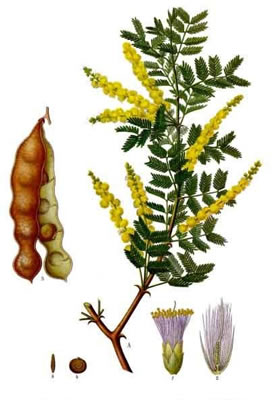Acacia Acacia senegal
- Common Names
- Acacia , Gum Arabic, Cassie flower, Catechu, Egyptian thorn
- Botanical Name
- Acacia senegal
- Family
- FABACEAE
Medicinal Uses & Benefits of Acacia
![]() How to Use|
Side Effects |
Plant & Garden|
Folklore
How to Use|
Side Effects |
Plant & Garden|
Folklore
- Medicinal Uses: * African
* Cuts & Wounds
* Sore Throat
- Properties: * Astringent * Demulcent * Emollient
- Parts Used: resin
- Constituents: complex polysaccharides and protein - arabinogalactan
How to Use: Acacia
Herbalists use acacia gum to bind pills and to stabilize emulsions. It is also used in aromatherapy for applying essential oils. Acacia (gum arabic) is used widely as an ingredient in foods like candies and soft drinks, the gum has the properties of a glue that is safe to eat. Acacia gum is widely used in organic products as natural alternative to chemical binders.
Preparation Methods & Dosage :Add acacia gum to homemade creams and lotions to stabilize and improve texture. Also used in aromatherapy as a resin and carrier for essential oils.
Acacia Side Effects: None noted
Plant Description

Franz Eugen Köhler, Köhler's Medizinal-Pflanzen (1887)
- Flowers:Small flowers have five very small petals, almost hidden by the long stamens, and are arranged in dense globular or cylindrical clusters; they are yellow or cream-colored in most species, whitish in some, even purple (Acacia purpureapetala) or red (Acacia leprosa)
- Plant Class:Shrub
- Leaves:Pinnate, feather-like, the plants often bear spines, especially those species growing in arid regions.
- Preferred Habitat:Tropical
- Flowering Season:Spring
- Distribution:Sub-Saharan Africa, most abundant in the Darfur region of Sudan
The acacia is a plant in the subfamily Mimosacaea(sometimes considered a family, Mimosaceae ) , of the flowering plant family Fabaceae(the legumes), of mostly tropical and subtropical trees and shrubs. The trees produce the most resin under stress conditions.1
Regional Traditions :African * Middle East *
Related Species
Acacia nilotica Indian gum arabic
Acacia seyhal talha
Acacia dealbataMimosa
History and Traditions & Folklore
The Egyptians used acacia as a fixative for ink, and to coat the bandages of mummys, and the gum is mentioned frequently in ancient Egyptian inscriptions. Acacia was used by the Egyptian, and pre-Egyptian healers in medicinal preparations for its soothing properties on inflamed mucus membranes, and to treat coughs and catarrh. Theophrastus, in the third and fourth centuries before Christ, described it, as also did Dioscorides and Pliny, under the name "Egyptian Gum." 2
Acacia has been connected to a reverence for the dead, resurrection and immortality in many religious traditions and magical contexts. Egyptians burned acacia wreaths to honor the dead, and Hebrews planted the trees to mark graves. In Voodun and African-American conjure acacia in used with Frankincense and Myrrh in rituals to contact the dead and to open the mind to visions. Catherine Yronwode Hoodoo Herb and Root Magic: A Materia Magica of African-American Conjure, and Traditional Formulary (2002).
Acacia has the mournful distinction of supplying the crown of thorns at Golgatha. Various other plants have been named in different countries, the hawthorn, barberry and holly among them, but in the Near East, where the legend arose, only the acacia was considered to be the provider of the spiny crown. Ernst and Johanna Lehner Folklore and Symbolism of Flowers, Plants and Trees (2003).













